Think Tax Season Is Over? Here Is When You Need to & How to File an Amended Return

Tax season is something that very few people look forward to. Unless you are an accountant, you probably hate this time of the year and are happy when your return is done, your refund is coming, or your tax debt is paid off. You might think that tax season is over when you send in your tax return. Unfortunately, that is not the case. Read on to find out why you need to file an amended return.
Every year, the IRS sends out letters to millions of Americans either informing them that they owe money or requesting information. Therefore, there might be instances when you may be required to review a previous tax return and file an amended one.
When to File an Amended Return?
So when and how should you file a revised tax return? Here are some essential facts you must know.
You Failed to Report All Income
If you failed to declare all of your income to the IRS, it is only a matter of time before the IRS finds out. You might find yourself on the receiving end of a significant bill when they do. Rather than waiting for the IRS to catch up, own up to your mistake and file an amended tax return.
Make sure to compile all your documents and compare the income you reported to the new amount you’ve calculated. If you owe additional tax, you should pay it immediately to avoid interest and penalties.
You Received Brokerage Forms Late
If you have investments in the stock market and mutual funds, you should receive forms from brokerage firms holding those accounts. These forms will give you information about your dividend income and capital gains, so you can provide the IRS with the correct information when you file your taxes.
You may not be aware that brokerage and mutual funds statements are occasionally received late. Even worse, the figures are often changed after the fact, so the data you included on your original tax return may no longer be correct.
If your brokerage firm sends you an updated 1099, you may need to file an amended tax return. If you neglect to keep your numbers current, the IRS may come after you with additional taxes and penalties.
You Received an Incorrect Tax Bill
Filing an amended tax return can often resolve the issue if you receive letters from the IRS stating that you owe money, despite being confident that you do not.
Keep in mind that the IRS is not perfect and does make errors. Finding yourself in this situation can often be tricky. So having a company that specializes in IRS relief on your side to rectify these mistakes and settle your tax liability is crucial.
You Failed to Claim a Valid Credit or Deduction
An amended return might help you minimize your tax bill if you missed a particular deduction or credit.
Even if you have submitted your tax return, you can still claim any deductions or credits you may have overlooked.
File Your Amended Return Within Three Years
You only have a short window of time to file an amended return. In most situations, you have three years to file your amended return. If you miss the deadline, you could lose any chance to file one and/or the right to claim a refund.
Check your tax records for the previous three years if you believe you will need to file an amended return. If you discover any potential problems or missed deductions or credits, it may be time to file your amended return.
You can always file an amended tax return even after the tax filing season ends. You may change previously filed tax returns to reflect past omissions or claim missed deductions if you are within the allowable time frame.
How to File an Amended Return
Filing an amended return is fairly easy. Here’s a step-by-step guide and tips for filing an amended tax return.
1. Gather the Necessary Documents
Prepare your original tax return and forms along with new supporting documents required to file an amended tax return, such as a new or updated W2 or 1099 form, schedules, and completed forms.
2. Complete the 1040X Form
The form you need to file when amending a return is Form 1040-X. If amending multi-year returns, you will need a separate Form 1040-X for each year.
The 1040X form includes three columns that must be completed:
- Column A: This is where you will enter the numbers corresponding to your income and the taxes withheld from your original return.
- Column B: This is where you will enter the net changes to your income and taxes between the original and amended filing.
- Column C: This is where you enter the right amount from your updated filing for income and taxes.
Part III of Form 1040-X requires you to explain why you’re filing an amended return.
3. Submit the Amended Return
The last step to filing is to mail your amended return to the IRS along with any supporting documents. If amending your tax return causes your total tax liability to increase, you will need to submit an additional tax payment. By doing so, you can reduce the amount of interest and penalties you’ll owe.
Owe Back Taxes?
If you owe back taxes, are being audited, or haven’t filed your tax returns for years, we strongly recommend you contact our firm. You never have to speak to the IRS. Our tax resolution services can help you save money and time in the long run. You may be eligible for various IRS relief programs or have your penalties waived or reduced. Consult with us today!
